2008 Seat Ibiza 5D engine coolant
[x] Cancel search: engine coolantPage 183 of 260
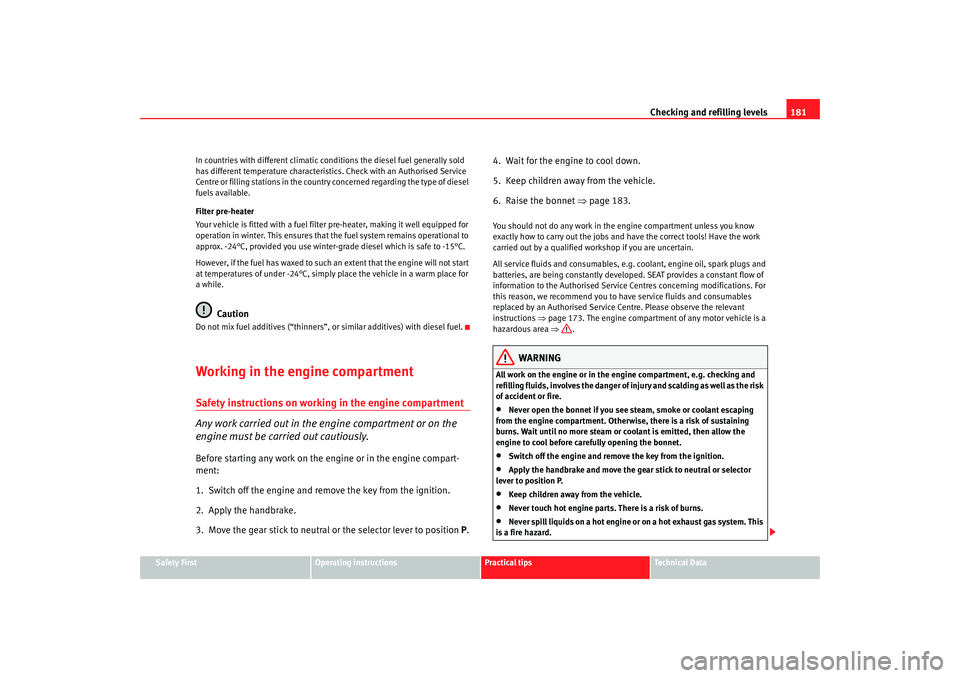
Checking and refilling levels181
Safety First
Operating instructions
Practical tips
Te c h n i c a l D a t a
In countries with different climatic conditions the diesel fuel generally sold
has different temperature characteristics. Check with an Authorised Service
Centre or filling stations in the country concerned regarding the type of diesel
fuels available.
Filter pre-heater
Your vehicle is fitted with a fuel filter pre-heater, making it well equipped for
operation in winter. This ensures that the fuel system remains operational to
approx. -24°C, provided you use winter-grade diesel which is safe to -15°C.
However, if the fuel has waxed to such an extent that the engine will not start
at temperatures of under -24°C, simply place the vehicle in a warm place for
a while.
Caution
Do not mix fuel additives (“thinners”,
or similar additives) with diesel fuel.Working in the engine compartmentSafety instructions on working in the engine compartment
Any work carried out in the engine compartment or on the
engine must be carried out cautiously.Before starting any work on the engine or in the engine compart-
ment:
1. Switch off the engine and remove the key from the ignition.
2. Apply the handbrake.
3. Move the gear stick to neutral or the selector lever to position P. 4. Wait for the engine to cool down.
5. Keep children away from the vehicle.
6. Raise the bonnet
⇒page 183.
You should not do any work in the engine compartment unless you know
exactly how to carry out the jobs and have the correct tools! Have the work
carried out by a qualified workshop if you are uncertain.
All service fluids and consumables, e.g. coolant, engine oil, spark plugs and
batteries, are being constantly developed. SEAT provides a constant flow of
information to the Authorised Service Centres concerning modifications. For
this reason, we recommend you to have service fluids and consumables
replaced by an Authorised Service Centre. Please observe the relevant
instructions ⇒page 173. The engine compartment of any motor vehicle is a
hazardous area ⇒ .
WARNING
All work on the engine or in the en gine compartment, e.g. checking and
refilling fluids, involves the danger of injury and scalding as well as the risk
of accident or fire.•
Never open the bonnet if you see steam, smoke or coolant escaping
from the engine compartment. Otherwise, there is a risk of sustaining
burns. Wait until no more steam or coolant is emitted, then allow the
engine to cool before carefully opening the bonnet.
•
Switch off the engine and remo ve the key from the ignition.
•
Apply the handbrake and move the gear stick to neutral or selector
lever to position P.
•
Keep children away from the vehicle.
•
Never touch hot engine parts. There is a risk of burns.
•
Never spill liquids on a hot engine or on a hot exhaust gas system. This
is a fire hazard.
Ibiza250_angles Seite 181 Dienstag, 5. August 2008 1:11 13
Page 184 of 260

Checking and refilling levels
182•
Avoid causing short-circuits in the electrical system, particularly at the
points where the jump leads are attached ⇒page 227. The battery could
explode.
•
Never touch the radiator fan. It is temperature controlled and could
start automatically, even when the engine has been switched off and the
key removed from the ignition!
•
Do not unscrew the cap on the expansion tank when the engine is hot.
If the coolant is hot, the cooling system will be pressurised!
•
Protect face, hands and arms by covering the cap with a large, thick
cloth to protect against escaping coolant and steam.
•
Always make sure you have not left any objects, such as cleaning cloths
and tools, in the engine compartment.
•
If you have to work underneath the vehicle, you must use suitable
stands additionally to support the vehicle, there is a risk of accident!. A
hydraulic jack is insufficient for securing the vehicle and there is a risk of
injury.
•
If any work has to be performed when the engine is started or with the
engine running, there is an additional, potentially fatal, safety risk from the
rotating parts, such as the drive belts, alternator, radiator fan, etc., and
from the high-voltage ignition syst em. You should also observe the
following points:
−Never touch the electrical wiri ng of the ignition system.
− Ensure that jewellery, loose clothing and long hair do not get
trapped in rotating engine parts. Danger of death. Before starting any
work remove jewellery, tie back and cover hair, and wear tight-fitting
clothes.
− Always think carefully about pressing the accelerator if a gear is
engaged in either an automatic or manual gearbox. The vehicle could
move, even if the handbrake is applied. Danger of death.
•
If work has to be carried out on the fuel system or on electrical compo-
nents, you must observe the following safety notes in addition to the above
warnings:
−Always disconnect the battery. The vehicle must be unlocked when
this is done, otherwise the alarm will be triggered.
− Do not smoke.
− Never work near naked flames.
− Always have a fire extinguisher on hand.Caution
When changing or topping up service fluids, make absolutely certain that you
fill the fluids into the correct reservoirs. Failure to observe this point will result
in serious malfunctions and engine damage!
For the sake of the environment
Service fluids leaks are harmful to th e environment. For this reason you
should make regular checks on the ground underneath your vehicle. If you
find spots of oil or other fluids, have your vehicle inspected in a qualified
workshop.
WARNING (continued)
WARNING (continued)
Ibiza250_angles Seite 182 Dienstag, 5. August 2008 1:11 13
Page 185 of 260
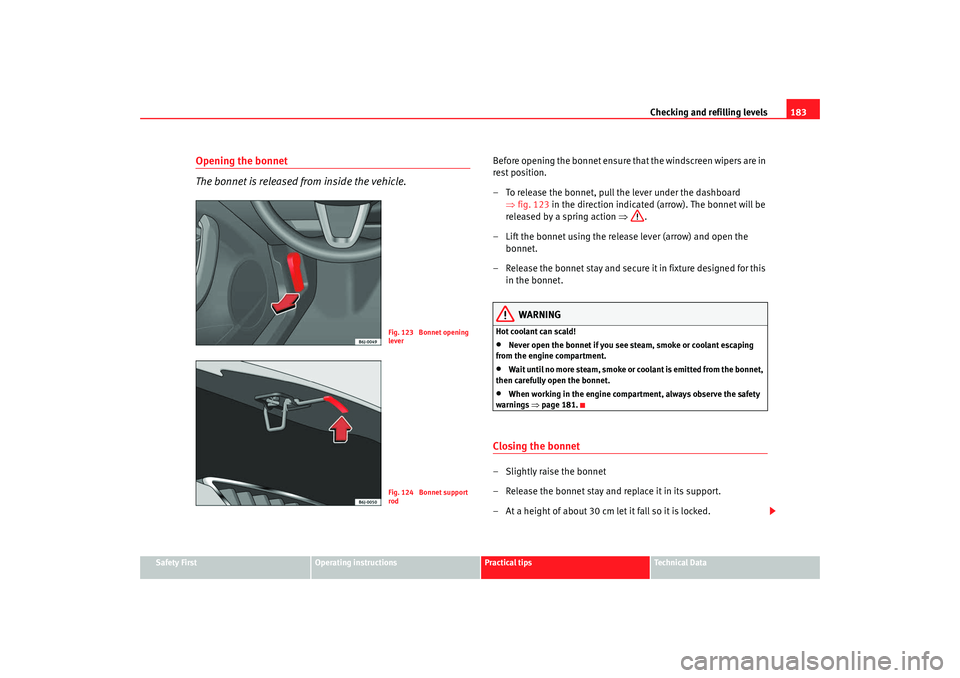
Checking and refilling levels183
Safety First
Operating instructions
Practical tips
Te c h n i c a l D a t a
Opening the bonnet
The bonnet is released from inside the vehicle.
Before opening the bonnet ensure that the windscreen wipers are in
rest position.
– To release the bonnet, pull the lever under the dashboard
⇒fig. 123 in the direction indicated (arrow). The bonnet will be
released by a spring action ⇒.
– Lift the bonnet using the rele ase lever (arrow) and open the
bonnet.
– Release the bonnet stay and secure it in fixture designed for this in the bonnet.
WARNING
Hot coolant can scald!•
Never open the bonnet if you see steam, smoke or coolant escaping
from the engine compartment.
•
Wait until no more steam, smoke or coolant is emitted from the bonnet,
then carefully open the bonnet.
•
When working in the engine compartm ent, always observe the safety
warnings ⇒page 181.
Closing the bonnet– Slightly raise the bonnet
– Release the bonnet stay and replace it in its support.
– At a height of about 30 cm let it fall so it is locked.
Fig. 123 Bonnet opening
leverFig. 124 Bonnet support
rod
Ibiza250_angles Seite 183 Dienstag, 5. August 2008 1:11 13
Page 190 of 260
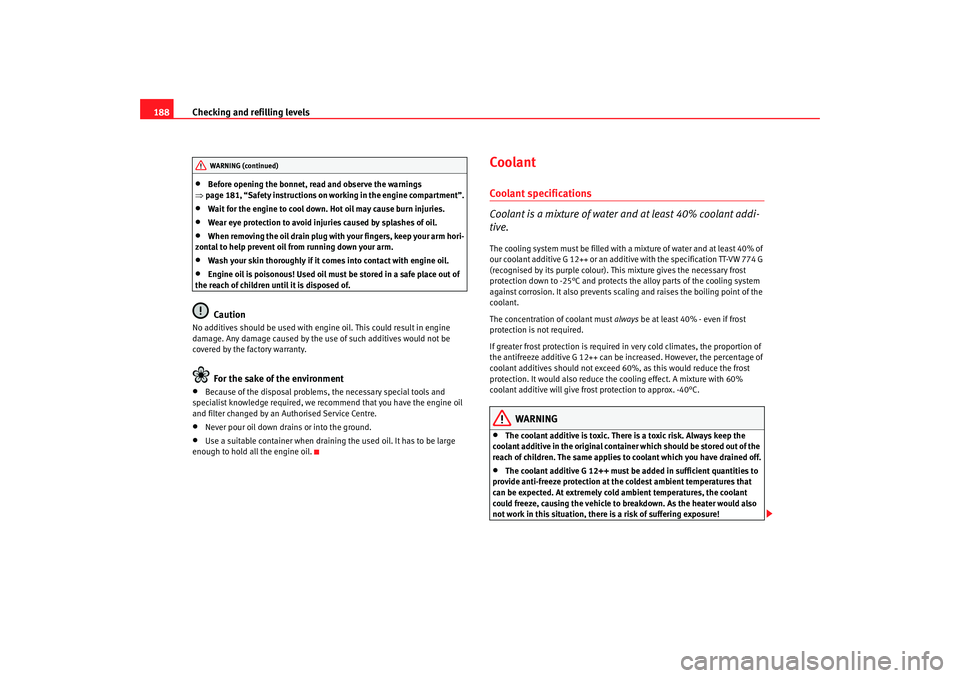
Checking and refilling levels
188•
Before opening the bonnet, read and observe the warnings
⇒ page 181, “Safety instructions on wo rking in the engine compartment”.
•
Wait for the engine to cool down. Hot oil may cause burn injuries.
•
Wear eye protection to avoid injuries caused by splashes of oil.
•
When removing the oil drain plug with your fingers, keep your arm hori-
zontal to help prevent oil from running down your arm.
•
Wash your skin thoroughly if it comes into contact with engine oil.
•
Engine oil is poisonous! Used oil must be stored in a safe place out of
the reach of children until it is disposed of.Caution
No additives should be used with engine oil. This could result in engine
damage. Any damage caused by the use of such additives would not be
covered by the factory warranty.
For the sake of the environment
•
Because of the disposal problems, the necessary special tools and
specialist knowledge required, we recommend that you have the engine oil
and filter changed by an Authorised Service Centre.
•
Never pour oil down drains or into the ground.
•
Use a suitable container when draining the used oil. It has to be large
enough to hold all the engine oil.
CoolantCoolant specifications
Coolant is a mixture of water and at least 40% coolant addi-
tive.The cooling system must be filled with a mixture of water and at least 40% of
our coolant additive G 12++ or an additive with the specification TT-VW 774 G
(recognised by its purple colour). T his mixture gives the necessary frost
protection down to -25°C and protects the alloy parts of the cooling system
against corrosion. It also prevents scal ing and raises the boiling point of the
coolant.
The concentration of coolant must always be at least 40% - even if frost
protection is not required.
If greater frost protection is required in very cold climates, the proportion of
the antifreeze additive G 12++ can be increased. However, the percentage of
coolant additives should not exceed 60%, as this would reduce the frost
protection. It would also reduce the cooling effect. A mixture with 60%
coolant additive will give frost protection to approx. -40°C.
WARNING
•
The coolant additive is toxic. Ther e is a toxic risk. Always keep the
coolant additive in the original container which should be stored out of the
reach of children. The same applies to coolant which you have drained off.
•
The coolant additive G 12++ must be added in sufficient quantities to
provide anti-freeze protection at the coldest ambient temperatures that
can be expected. At extremely cold ambient temperatures, the coolant
could freeze, causing the vehicle to breakdown. As the heater would also
not work in this situation, there is a risk of suffering exposure!
WARNING (continued)
Ibiza250_angles Seite 188 Dienstag, 5. August 2008 1:11 13
Page 191 of 260
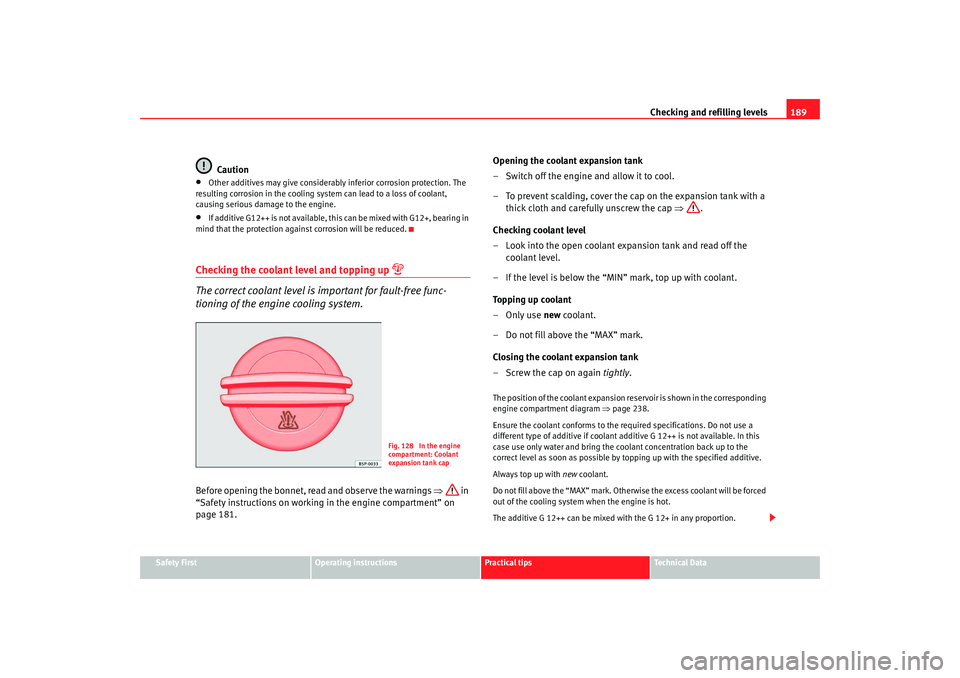
Checking and refilling levels189
Safety First
Operating instructions
Practical tips
Te c h n i c a l D a t a
Caution
•
Other additives may give considerably inferior corrosion protection. The
resulting corrosion in the cooling system can lead to a loss of coolant,
causing serious damage to the engine.
•
If additive G12++ is not available, t his can be mixed with G12+, bearing in
mind that the protection against corrosion will be reduced.
Checking the coolant level and topping up
The correct coolant level is important for fault-free func-
tioning of the engine cooling system.Before opening the bonnet, read and observe the warnings ⇒ in
“Safety instructions on working in the engine compartment” on
page 181. Opening the coolant expansion tank
– Switch off the engine and allow it to cool.
– To prevent scalding, cover the cap on the expansion tank with a
thick cloth and carefully unscrew the cap ⇒.
Checking coolant level
– Look into the open coolant expansion tank and read off the coolant level.
– If the level is below the “MIN” mark, top up with coolant.
Topping up coolant
–Only use new coolant.
– Do not fill above the “MAX” mark.
Closing the coolant expansion tank
–Screw the cap on again tightly.
The position of the coolant expansion reservoir is shown in the corresponding
engine compartment diagram ⇒page 238.
Ensure the coolant conforms to the required specifications. Do not use a
different type of additive if coolant ad ditive G 12++ is not available. In this
case use only water and bring the coolant concentration back up to the
correct level as soon as possible by topping up with the specified additive.
Always top up with new coolant.
Do not fill above the “MAX” mark. Otherwise the excess coolant will be forced
out of the cooling system when the engine is hot.
The additive G 12++ can be mixed with the G 12+ in any proportion.
Fig. 128 In the engine
compartment: Coolant
expansion tank cap
Ibiza250_angles Seite 189 Dienstag, 5. August 2008 1:11 13
Page 192 of 260
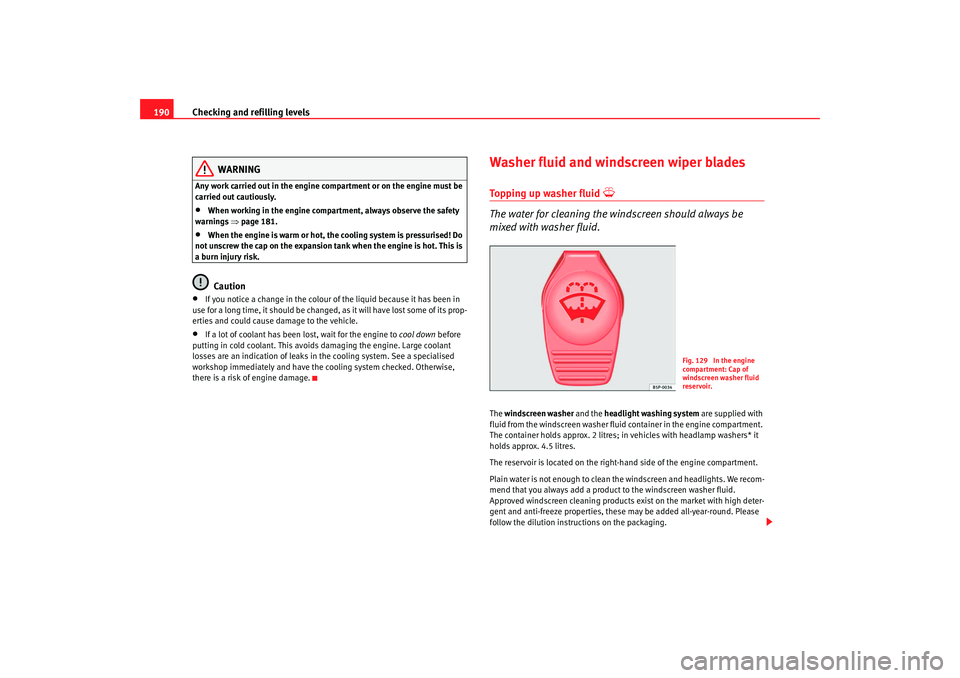
Checking and refilling levels
190
WARNING
Any work carried out in the engine compartment or on the engine must be
carried out cautiously.•
When working in the engine compartment, always observe the safety
warnings ⇒ page 181.
•
When the engine is warm or hot, th e cooling system is pressurised! Do
not unscrew the cap on the expansion t ank when the engine is hot. This is
a burn injury risk.Caution
•
If you notice a change in the colour of the liquid because it has been in
use for a long time, it should be changed, as it will have lost some of its prop-
erties and could cause damage to the vehicle.
•
If a lot of coolant has been lost, wait for the engine to cool down before
putting in cold coolant. This avoids damaging the engine. Large coolant
losses are an indication of leaks in the cooling system. See a specialised
workshop immediately and have the cooling system checked. Otherwise,
there is a risk of engine damage.
Washer fluid and windscreen wiper bladesTopping up washer fluid
The water for cleaning the windscreen should always be
mixed with washer fluid.The windscreen washer and the headlight washing system are supplied with
fluid from the windscreen washer fluid container in the engine compartment.
The container holds approx. 2 litres; in vehicles with headlamp washers* it
holds approx. 4.5 litres.
The reservoir is located on the right-hand side of the engine compartment.
Plain water is not enough to clean the windscreen and headlights. We recom-
mend that you always add a product to the windscreen washer fluid.
Approved windscreen cleaning products exist on the market with high deter-
gent and anti-freeze properties, these may be added all-year-round. Please
follow the dilution instructions on the packaging.
Fig. 129 In the engine
compartment: Cap of
windscreen washer fluid
reservoir.
Ibiza250_angles Seite 190 Dienstag, 5. August 2008 1:11 13
Page 240 of 260
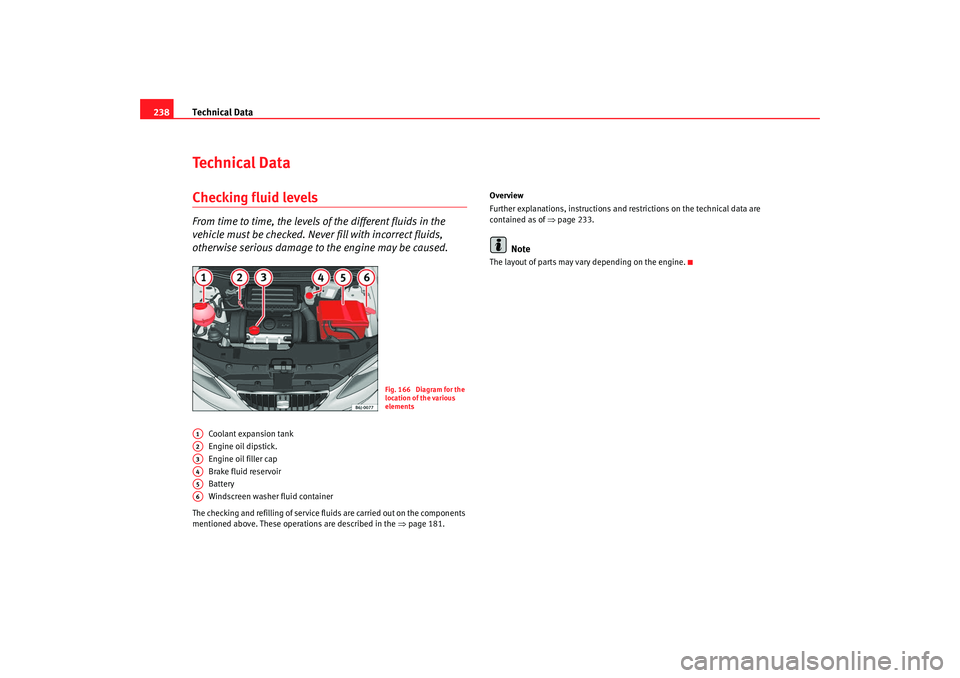
Technical Data
238Te c h n i c a l D a t aChecking fluid levelsFrom time to time, the levels of the different fluids in the
vehicle must be checked. Never fill with incorrect fluids,
otherwise serious damage to the engine may be caused.
Coolant expansion tank
Engine oil dipstick.
Engine oil filler cap
Brake fluid reservoir
Battery
Windscreen washer fluid container
The checking and refilling of service fluids are carried out on the components
mentioned above. These operations are described in the ⇒page 181. Overview
Further explanations, instructions and restrictions on the technical data are
contained as of
⇒page 233.
Note
The layout of parts may vary depending on the engine.
Fig. 166 Diagram for the
location of the various
elements
A1A2A3A4A5A6
Ibiza250_angles Seite 238 Dienstag, 5. August 2008 1:11 13
Page 252 of 260
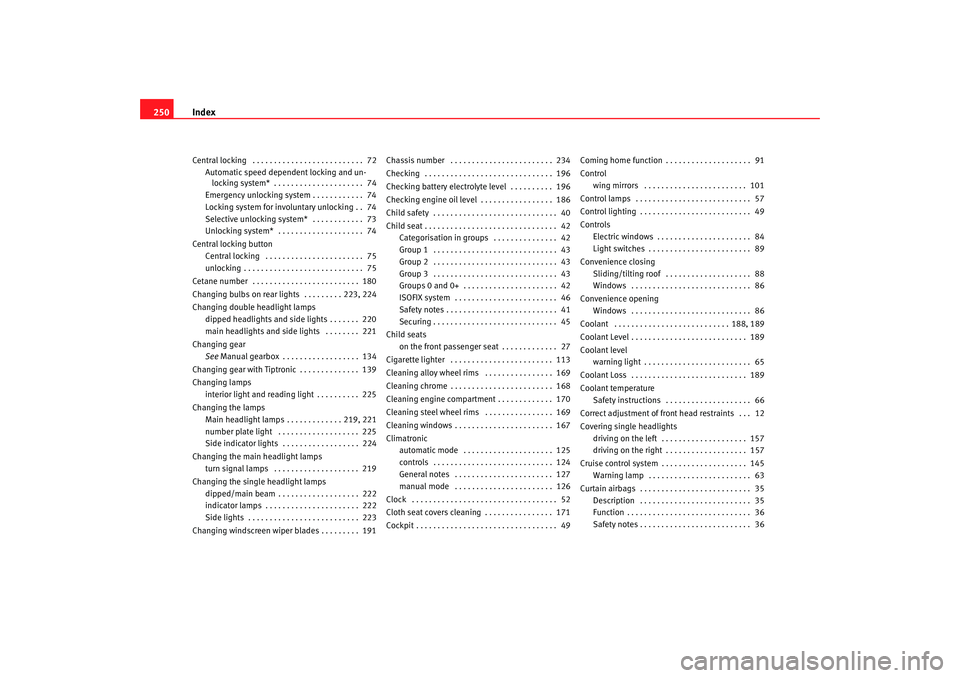
Index
250Central locking . . . . . . . . . . . . . . . . . . . . . . . . . . 72
Automatic speed dependent locking and un-locking system* . . . . . . . . . . . . . . . . . . . . . 74
Emergency unlocking system . . . . . . . . . . . . 74
Locking system for invo luntary unlocking . . 74
Selective unlocking system* . . . . . . . . . . . . 73
Unlocking system* . . . . . . . . . . . . . . . . . . . . 74
Central locking button Central locking . . . . . . . . . . . . . . . . . . . . . . . 75
unlocking . . . . . . . . . . . . . . . . . . . . . . . . . . . . 75
Cetane number . . . . . . . . . . . . . . . . . . . . . . . . . 180
Changing bulbs on rear lights . . . . . . . . . 223, 224
Changing double headlight lamps dipped headlights and side lights . . . . . . . 220
main headlights and side lights . . . . . . . . 221
Changing gear See Manual gearbox . . . . . . . . . . . . . . . . . . 134
Changing gear with Tiptronic . . . . . . . . . . . . . . 139
Changing lamps interior light and reading light . . . . . . . . . . 225
Changing the lamps Main headlight lamps . . . . . . . . . . . . . 219, 221
number plate light . . . . . . . . . . . . . . . . . . . 225
Side indicator lights . . . . . . . . . . . . . . . . . . 224
Changing the main headlight lamps
turn signal lamps . . . . . . . . . . . . . . . . . . . . 219
Changing the singl e headlight lamps
dipped/main beam . . . . . . . . . . . . . . . . . . . 222
indicator lamps . . . . . . . . . . . . . . . . . . . . . . 222
Side lights . . . . . . . . . . . . . . . . . . . . . . . . . . 223
Changing windscreen wiper blades . . . . . . . . . 191 Chassis number . . . . . . . . . . . . . . . . . . . . . . . . 234
Checking . . . . . . . . . . . . . . . . . . . . . . . . . . . . . . 196
Checking battery electrolyte level . . . . . . . . . . 196
Checking engine oil level . . . . . . . . . . . . . . . . . 186
Child safety . . . . . . . . . . . . . . . . . . . . . . . . . . . . . 40
Child seat . . . . . . . . . . . . . . . . . . . . . . . . . . . . . . . 42
Categorisation in groups . . . . . . . . . . . . . . . 42
Group 1 . . . . . . . . . . . . . . . . . . . . . . . . . . . . . 43
Group 2 . . . . . . . . . . . . . . . . . . . . . . . . . . . . . 43
Group 3 . . . . . . . . . . . . . . . . . . . . . . . . . . . . . 43
Groups 0 and 0+ . . . . . . . . . . . . . . . . . . . . . . 42
ISOFIX system . . . . . . . . . . . . . . . . . . . . . . . . 46
Safety notes . . . . . . . . . . . . . . . . . . . . . . . . . . 41
Securing . . . . . . . . . . . . . . . . . . . . . . . . . . . . . 45
Child seats on the front passenger seat . . . . . . . . . . . . . 27
Cigarette lighter . . . . . . . . . . . . . . . . . . . . . . . . 113
Cleaning alloy wheel rims . . . . . . . . . . . . . . . . 169
Cleaning chrome . . . . . . . . . . . . . . . . . . . . . . . . 168
Cleaning engine compartment . . . . . . . . . . . . . 170
Cleaning steel wheel rims . . . . . . . . . . . . . . . . 169
Cleaning windows . . . . . . . . . . . . . . . . . . . . . . . 167
Climatronic automatic mode . . . . . . . . . . . . . . . . . . . . . 125
controls . . . . . . . . . . . . . . . . . . . . . . . . . . . . 124
General notes . . . . . . . . . . . . . . . . . . . . . . . 127
manual mode . . . . . . . . . . . . . . . . . . . . . . . 126
Clock . . . . . . . . . . . . . . . . . . . . . . . . . . . . . . . . . . 52
Cloth seat covers cleaning . . . . . . . . . . . . . . . . 171
Cockpit . . . . . . . . . . . . . . . . . . . . . . . . . . . . . . . . . 49 Coming home function . . . . . . . . . . . . . . . . . . . . 91
Control
wing mirrors . . . . . . . . . . . . . . . . . . . . . . . . 101
Control lamps . . . . . . . . . . . . . . . . . . . . . . . . . . . 57
Control lighting . . . . . . . . . . . . . . . . . . . . . . . . . . 49
Controls Electric windows . . . . . . . . . . . . . . . . . . . . . . 84
Light switches . . . . . . . . . . . . . . . . . . . . . . . . 89
Convenience closing Sliding/tilting roof . . . . . . . . . . . . . . . . . . . . 88
Windows . . . . . . . . . . . . . . . . . . . . . . . . . . . . 86
Convenience opening Windows . . . . . . . . . . . . . . . . . . . . . . . . . . . . 86
Coolant . . . . . . . . . . . . . . . . . . . . . . . . . . . 188, 189
Coolant Level . . . . . . . . . . . . . . . . . . . . . . . . . . . 189
Coolant level warning light . . . . . . . . . . . . . . . . . . . . . . . . . 65
Coolant Loss . . . . . . . . . . . . . . . . . . . . . . . . . . . 189
Coolant temperature Safety instructions . . . . . . . . . . . . . . . . . . . . 66
Correct adjustment of fron t head restraints . . . 12
Covering single headlights driving on the left . . . . . . . . . . . . . . . . . . . . 157
driving on the right . . . . . . . . . . . . . . . . . . . 157
Cruise control system . . . . . . . . . . . . . . . . . . . . 145 Warning lamp . . . . . . . . . . . . . . . . . . . . . . . . 63
Curtain airbags . . . . . . . . . . . . . . . . . . . . . . . . . . 35 Description . . . . . . . . . . . . . . . . . . . . . . . . . . 35
Function . . . . . . . . . . . . . . . . . . . . . . . . . . . . . 36
Safety notes . . . . . . . . . . . . . . . . . . . . . . . . . . 36
Ibiza250_angles Seite 250 Dienstag, 5. August 2008 1:11 13